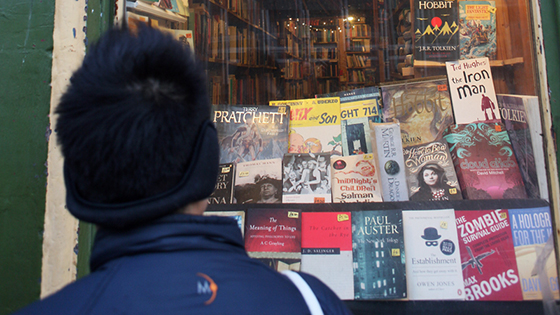
Theatric Prose
Gerald Maa on diving into Thomas de Quincey's papers at the National Library of Scotland
Gerald Maa is a PhD candidate in the Department of English. He received a 2016 graduate student research grant from the Humanities Commons.Tell us a bit about your dissertation project.
My research argues that a literary form that I call theatric prose emerged in late Georgian and early Victorian England. By theatric prose, I mean the appropriation of stage technique for literary prose style. As the popularity of the periodical boomed in the first half of the nineteenth century, essayists exploited, I contend, techniques from the most popular literary medium, theater, to establish its popularity, one that would supersede that of the theater house. Furthermore, as I see it, theatric prose, the imbrication of the era’s two most wildly popular and baldly political literary media, was instrumental to the English project of forging a national character larger than itself, British national character, which occurred during the transition years between victory at Waterloo and the height of Victorian liberalism. My dissertation starts the project by determining the essayist Thomas De Quincey as the most formative inventor and practitioner of theatric prose.
What discoveries did you make in the archives at the National Library of Scotland that advanced your research?
The National Library of Scotland, in Edinburgh, has one of the largest collections of Thomas De Quincey’s papers, because he spent most of his life living in and around the Scottish capital, most importantly the decades that constitute his writing career at the end of his life. The archive possesses all his correspondence with the journal that was his primary publication locale throughout his entire writing career, Blackwood’s. Reading through decades’ worth of daily letters provided a “behind the scenes” look at the long relationship between De Quincey and the Blackwoods (William, Alexander, and Robert), which is adequate in characterizing De Quincey’s general relationship with periodical culture. The National Library also possesses numerous other letters—some of them well-known—to and from people like William Tait, William Wordsworth, and John Wilson. The letters have advanced my dissertation most immediately by depicting the “grief of mind” (as De Quincey said in a letter) that plagued De Quincey’s mind in the early 1820s, the years around which my current chapter focuses. These letters have given me substance and insight by which to unpack a hitherto under-recognized essay by De Quincey called “Madness,” allowing me to theorize De Quinceyan madness into a conceptual lynchpin for my current chapter-in-progress. During my month overseas, I have also found in the manuscripts one footnote—unpublished, as far as I can tell—that will certainly be a centerpiece for a section in a future chapter. These are all the contributions clear to me at the moment. Doubtless, more will materialize as I continue to make progress on the dissertation.
As a first-time researcher in the archives, what challenges did you face? What did you enjoy most about archival research?
1. Over-abundance. 2. Penmanship. The second of these two main challenges resulted in one of the most enjoyable experiences: I found that getting acquainted to one’s penmanship, particularly from a bygone era, is a uniquely intimate experience.
What was one of your favorite experiences outside of the archives during your month in Scotland?
Hard to choose from the many and variegated. Right now, while answering these questions, one that stands prominently in mind is visiting De Quincey’s grave. I was reading Frances Wilson’s fine biography of De Quincey, Guilty Thing, while on the research trip, and I found out within the last few days of time in Edinburgh that he is buried in the middle of the city, right next to the iconic castle, at St. Cuthbert’s. I visited twice. The first time on a lark, during a study break. I took one of those many cobblestone roads that wend, rise, fall from place to place. (Samuel Taylor Coleridge once described the undulous Edinburgh as a city seen in “a Brobdingnag spoon.”) When there, I walked to each muddy corner, combed through each row in the two large squares, not able to find De Quincey’s headstone. Some were so worn down as to be illegible, some had fallen over, and a few were undergoing restoration work. I feared, irrationally, that it couldn’t be found. I dipped into the church, asked the volunteer at the front if he knew who De Quincey is, and if so, where his grave is. “Oh, yes—that famous writer.” He has many visitors, but it’s hard to find, tucked away. I visited a second time for a rubbing. A rainbow appeared for a minute or so, it’s odd to say, and it rained for a handful more, while I piecemealed my rubbing across two pieces of sketch paper. It made its way home.
